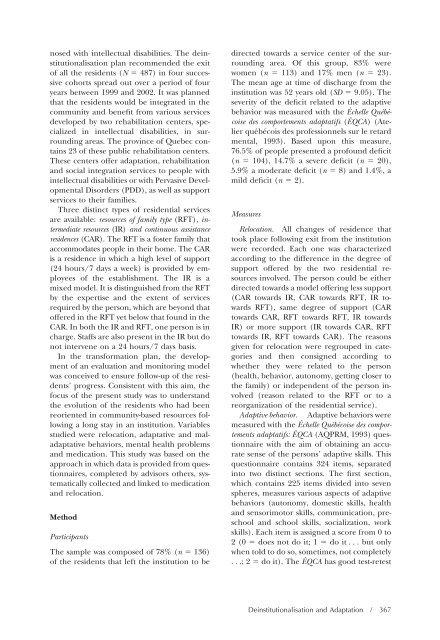Education and Training in Autism and Developmental Disabilities
Education and Training in Autism and Developmental Disabilities
Education and Training in Autism and Developmental Disabilities
You also want an ePaper? Increase the reach of your titles
YUMPU automatically turns print PDFs into web optimized ePapers that Google loves.
nosed with <strong>in</strong>tellectual disabilities. The de<strong>in</strong>stitutionalisation<br />
plan recommended the exit<br />
of all the residents (N 487) <strong>in</strong> four successive<br />
cohorts spread out over a period of four<br />
years between 1999 <strong>and</strong> 2002. It was planned<br />
that the residents would be <strong>in</strong>tegrated <strong>in</strong> the<br />
community <strong>and</strong> benefit from various services<br />
developed by two rehabilitation centers, specialized<br />
<strong>in</strong> <strong>in</strong>tellectual disabilities, <strong>in</strong> surround<strong>in</strong>g<br />
areas. The prov<strong>in</strong>ce of Quebec conta<strong>in</strong>s<br />
23 of these public rehabilitation centers.<br />
These centers offer adaptation, rehabilitation<br />
<strong>and</strong> social <strong>in</strong>tegration services to people with<br />
<strong>in</strong>tellectual disabilities or with Pervasive <strong>Developmental</strong><br />
Disorders (PDD), as well as support<br />
services to their families.<br />
Three dist<strong>in</strong>ct types of residential services<br />
are available: resources of family type (RFT), <strong>in</strong>termediate<br />
resources (IR) <strong>and</strong> cont<strong>in</strong>uous assistance<br />
residences (CAR). The RFT is a foster family that<br />
accommodates people <strong>in</strong> their home. The CAR<br />
is a residence <strong>in</strong> which a high level of support<br />
(24 hours/7 days a week) is provided by employees<br />
of the establishment. The IR is a<br />
mixed model. It is dist<strong>in</strong>guished from the RFT<br />
by the expertise <strong>and</strong> the extent of services<br />
required by the person, which are beyond that<br />
offered <strong>in</strong> the RFT yet below that found <strong>in</strong> the<br />
CAR. In both the IR <strong>and</strong> RFT, one person is <strong>in</strong><br />
charge. Staffs are also present <strong>in</strong> the IR but do<br />
not <strong>in</strong>tervene on a 24 hours/7 days basis.<br />
In the transformation plan, the development<br />
of an evaluation <strong>and</strong> monitor<strong>in</strong>g model<br />
was conceived to ensure follow-up of the residents’<br />
progress. Consistent with this aim, the<br />
focus of the present study was to underst<strong>and</strong><br />
the evolution of the residents who had been<br />
reoriented <strong>in</strong> community-based resources follow<strong>in</strong>g<br />
a long stay <strong>in</strong> an <strong>in</strong>stitution. Variables<br />
studied were relocation, adaptative <strong>and</strong> maladaptative<br />
behaviors, mental health problems<br />
<strong>and</strong> medication. This study was based on the<br />
approach <strong>in</strong> which data is provided from questionnaires,<br />
completed by advisors others, systematically<br />
collected <strong>and</strong> l<strong>in</strong>ked to medication<br />
<strong>and</strong> relocation.<br />
Method<br />
Participants<br />
The sample was composed of 78% (n 136)<br />
of the residents that left the <strong>in</strong>stitution to be<br />
directed towards a service center of the surround<strong>in</strong>g<br />
area. Of this group, 83% were<br />
women (n 113) <strong>and</strong> 17% men (n 23).<br />
The mean age at time of discharge from the<br />
<strong>in</strong>stitution was 52 years old (SD 9.05). The<br />
severity of the deficit related to the adaptive<br />
behavior was measured with the Échelle Québécoise<br />
des comportements adaptatifs (ÉQCA) (Atelier<br />
québécois des professionnels sur le retard<br />
mental, 1993). Based upon this measure,<br />
76.5% of people presented a profound deficit<br />
(n 104), 14.7% a severe deficit (n 20),<br />
5.9% a moderate deficit (n 8) <strong>and</strong> 1.4%, a<br />
mild deficit (n 2).<br />
Measures<br />
Relocation. All changes of residence that<br />
took place follow<strong>in</strong>g exit from the <strong>in</strong>stitution<br />
were recorded. Each one was characterized<br />
accord<strong>in</strong>g to the difference <strong>in</strong> the degree of<br />
support offered by the two residential resources<br />
<strong>in</strong>volved. The person could be either<br />
directed towards a model offer<strong>in</strong>g less support<br />
(CAR towards IR, CAR towards RFT, IR towards<br />
RFT), same degree of support (CAR<br />
towards CAR, RFT towards RFT, IR towards<br />
IR) or more support (IR towards CAR, RFT<br />
towards IR, RFT towards CAR). The reasons<br />
given for relocation were regrouped <strong>in</strong> categories<br />
<strong>and</strong> then consigned accord<strong>in</strong>g to<br />
whether they were related to the person<br />
(health, behavior, autonomy, gett<strong>in</strong>g closer to<br />
the family) or <strong>in</strong>dependent of the person <strong>in</strong>volved<br />
(reason related to the RFT or to a<br />
reorganization of the residential service).<br />
Adaptive behavior. Adaptive behaviors were<br />
measured with the Échelle Québécoise des comportements<br />
adaptatifs: ÉQCA (AQPRM, 1993) questionnaire<br />
with the aim of obta<strong>in</strong><strong>in</strong>g an accurate<br />
sense of the persons’ adaptive skills. This<br />
questionnaire conta<strong>in</strong>s 324 items, separated<br />
<strong>in</strong>to two dist<strong>in</strong>ct sections. The first section,<br />
which conta<strong>in</strong>s 225 items divided <strong>in</strong>to seven<br />
spheres, measures various aspects of adaptive<br />
behaviors (autonomy, domestic skills, health<br />
<strong>and</strong> sensorimotor skills, communication, preschool<br />
<strong>and</strong> school skills, socialization, work<br />
skills). Each item is assigned a score from 0 to<br />
2(0 does not do it; 1 doit...butonly<br />
when told to do so, sometimes, not completely<br />
...;2 do it). The ÉQCA has good test-retest<br />
De<strong>in</strong>stitutionalisation <strong>and</strong> Adaptation / 367

















